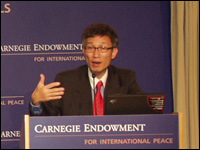Registration
You will receive an email confirming your registration.
IMGXYZ819IMGZYXOn November 20, 2007, Director of China Program Minxin Pei discussed his latest policy brief Corruption Threatens China’s Future in a seminar hosted by the Carnegie Endowment. The presentation was followed by a critique from Daniel Kaufmann, Director of Global Program at the World Bank Institute and also a leading authority on corruption and governance around the world.
Pei’s policy brief assesses corruption in China based on five key questions: How serious is the corruption? What are the trends? What are the symptoms? What are the causes? And finally, how have the government handled the problem so far?
Pei first admitted that there are enormous research difficulties in attaining high quality, reliable, and standardized survey data on the severity of corruption in China. Nevertheless, indicators assembled from a variety of sources presented a sobering picture of the situation. For example, various domestic surveys conducted at both elite and mass levels have consistently ranked corruption as one of China’s top political challenges and social problems. A large number of anecdotal evidence collected from press reports over the past decade also conveys the impression that the cost of corruption, measured in monetary term, has grown, and involvement by mid-level (or even senior) officials has increased as well.
Meanwhile, anti-corruption measures from the government remain ineffective due to the insufficient enforcement of those laws. Lack of transparency regarding the operational procedure within the Central Commission of Discipline Inspection further complicates the picture, leaving unclear how allegedly corrupt officials are discipline and punished. According to data provided by the report, the odds of a corrupt official end up in jail are less than 3 percent, therefore making corruption a high-return, low risk activity. Such leniency of punishment has been one of the primary factors that make corruption a very serious problem in China.
Pei’s report estimates that the direct costs of corruption in China are about 3 percents of annual GDP. Worse yet, most of the cases are concentrated in critical sectors with extensive state involvement, such as infrastructure projects, financial services, real estate, and government procurement. The absence of competitive political process and free press makes these high-risk sectors even more susceptible to fraud, theft, kickbacks, and bribery.
Pei also pointed out that corruption in China has evolved in two major ways. First of all, in some of the cases corruptions have been taken in forms of ostensibly legal official expenditures (or “privatized official consumption”). For example, more and more local governments have started to build massive administrative office buildings that resemble luxurious mansions. Secondly, many of the corrupted local officials have transformed their jurisdictions into virtual “mafia states,” where they collude with criminal elements and unsavory businessmen in illegal activities
Although the central government in Beijing has constantly come up with new laws and initiatives to battle against corruption, Pei doubted there would be any major progresses. As long as the Central Commission of Discipline Inspection remains in- transparent, and as long as the government continues to limit the role of the media and NGOs in maintaining government integrity, corruption would still be one of the largest threats to China’s future.
Daniel Kaufmann from the World Bank commented Pei’s policy brief with three questions. First of all, how has the data been interpreted in the report, regardless the accuracy of data itself? Interpreting data is very tricky. For example, the top two countries with highest per capita rate of imprisonment due to corruption are U.S and Russia. But what does this tell us? Does it mean that the U.S has the highest crime rate in the world? In other words, data can be interpreted in various ways to reach different conclusions. Kaufmann then reminded the audience that corruption has plagued China for decades, yet its economy continues to perform robustly. Therefore, how much more damage could corruption do to China? Has China beaten the odds? Finally, is corruption the root of all problems that plague China’s political system today, or is it merely a symptom that caused by other factors?
This summary was prepared by Wayne Chen, Junior Fellow in the China Program.
